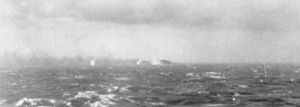Bismarck Chase
| The last battle of the battleship Bismarck | |||||||
|---|---|---|---|---|---|---|---|
| Part of the Battle of the Atlantic | |||||||
 The Final Battle, 27 May 1941. Surrounded by shell splashes, Bismarck burns on the horizon. |
|||||||
|
|||||||
| Belligerents | |||||||
|
|
|
||||||
| Commanders and leaders | |||||||
|
|
|
||||||
| Strength | |||||||
| 1 aircraft carrier 2 battleships 3 cruisers 6 destroyers |
1 battleship | ||||||
| Casualties and losses | |||||||
| 1 light cruiser lightly damaged (3 killed, 2 wounded.) |
1 battleship scuttled 2,200 dead 110 captured |
||||||
The last battle of the German battleship Bismarck took place in the Atlantic Ocean approximately 300 nmi (350 mi; 560 km) west of Brest, France, on 26–27 May 1941. Although it was a decisive action between capital ships, it has no generally accepted name.
On 24 May, before the final action, Bismarck's fuel tanks were damaged and several machinery compartments, including a boiler room, were flooded in the Battle of the Denmark Strait. Her intention was to reach the port of Brest for repair. Late in the day Bismarck briefly turned on her pursuers (Prince of Wales and the heavy cruisers Norfolk and Suffolk) to cover the escape of her companion, the heavy cruiser Prinz Eugen to continue further into the Atlantic. Early on 25 May the British forces lost contact with Bismarck, which headed ESE towards France while the British searched NE, presuming she was returning to Norway. Later on 25 May Admiral Lütjens, apparently unaware that he had lost his pursuers, broke radio silence to send a coded message to Germany. This allowed the British to triangulate the approximate position of the Bismarck and aircraft were dispatched to hunt for the German battleship. She was rediscovered in the late morning of 26 May by a Catalina flying boat from No. 209 Squadron RAF and subsequently shadowed by aircraft from Force H steaming north from Gibraltar.
The final action consisted of four main phases. The first phase late on the 26th consisted of air strikes by torpedo bombers from the British aircraft carrier Ark Royal, which disabled Bismarck's steering gear, jamming her rudders in a turning position and preventing her escape. The second phase was the shadowing and harassment of Bismarck during the night of 26/27 May by British destroyers, with no serious damage to any ship. The third phase on the morning of 27 May was an attack by the British battleships King George V and Rodney supported by cruisers. After about 100 minutes of fighting, Bismarck was sunk by the combined effects of shellfire, torpedo hits and deliberate scuttling. On the British side, Rodney was lightly damaged by near-misses and by the blast effects of her own guns. British warships rescued 111 survivors from Bismarck before being obliged to withdraw because of an apparent U-boat sighting, leaving several hundred men to their fate. The following morning, a U-boat and German weathership rescued five more survivors. In the final phase the withdrawing British ships were attacked on 27 May by aircraft of the Luftwaffe, resulting in the loss of the destroyer HMS Mashona.
...
Wikipedia
